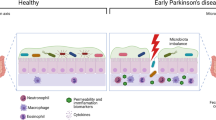Abstract
Physicians, caregivers and patients themselves must be alert to the onset of and changes in motor and non-motor features during the course of Parkinson’s disease (PD). Parallel laboratory routine assessments are necessary because of the evolving impairment of the general health status of the individual. A number of potential biomarkers for the diagnosis of PD are currently under investigation, with diagnosis early in the disease course a particular goal, even before the onset of motor symptoms. The aim of this guideline article is to provide user-friendly, clinical evidence-based recommendations for using laboratory pathological testing for the diagnosis and differential diagnosis of PD, for assessing its time course, and managing complications of long-term dopaminergic therapy and the disabling motor features that develop in the later stages of the disease.
Similar content being viewed by others
References
Aarsland D, Taylor JP, Weintraub D (2014) Psychiatric issues in cognitive impairment. Mov Disord 29:651–662
Al-Nimer MS, Mshatat SF, Abdulla HI (2014) Saliva alpha-synuclein and a high extinction coefficient protein: a novel approach in assessment biomarkers of Parkinson’s disease. N Am J Med Sci 6:633–637
Berg D, Godau J, Seppi K, Behnke S, Liepelt-Scarfone I, Lerche S, Stockner H, Gaenslen A, Mahlknecht P, Huber H, Srulijes K, Klenk J, Fassbender K, Maetzler W, Poewe W (2013) The PRIPS study: screening battery for subjects at risk for Parkinson’s disease. Eur J Neurol 20:102–108
Braak H, Del TK, Rub U, de Vos RA, Jansen Steur EN, Braak E (2003) Staging of brain pathology related to sporadic Parkinson’s disease. Neurobiol Aging 24:197–211
Burke RE, Dauer WT, Vonsattel JP (2008) A critical evaluation of the Braak staging scheme for Parkinson’s disease. Ann Neurol 64:485–491
Chaudhuri KR, Schapira AH (2009) Non-motor symptoms of Parkinson’s disease: dopaminergic pathophysiology and treatment. Lancet Neurol 8:464–474
Devic I, Hwang H, Edgar JS, Izutsu K, Presland R, Pan C, Goodlett DR, Wang Y, Armaly J, Tumas V, Zabetian CP, Leverenz JB, Shi M, Zhang J (2011) Salivary alpha-synuclein and DJ-1: potential biomarkers for Parkinson’s disease. Brain 134:e178
Figee M, de Koning P, Klaassen S, Vulink N, Mantione M, van den Munckhof P, Schuurman R (2014) Deep brain stimulation induces striatal dopamine release in obsessive-compulsive disorder. Biol Psychiatry 75:647–652
Gerlach M, Maetzler W, Broich K, Hampel H, Rems L, Reum T, Riederer P, Stoffler A, Streffer J, Berg D (2012) Biomarker candidates of neurodegeneration in Parkinson’s disease for the evaluation of disease-modifying therapeutics. J Neural Transm 119:39–52
Manca D, Cossu G, Murgia D, Molari A, Ferrigno P, Marcia E, Melis M (2009) Reversible encephalopathy and axonal neuropathy in Parkinson’s disease during duodopa therapy. Mov Disord 24:2293–2294
Martignoni E, Cosentino M, Ferrari M, Porta G, Mattarucchi E, Marino F, Lecchini S, Nappi G (2005) Two patients with COMT inhibitor-induced hepatic dysfunction and UGT1A9 genetic polymorphism. Neurology 65:1820–1822
Martinez-Horta S, Pagonabarraga J, de Fernandez BR, Garcia-Sanchez C, Kulisevsky J (2013) Apathy in Parkinson’s disease: more than just executive dysfunction. J Int Neuropsychol Soc 19:571–582
Meissner W, Reum T, Paul G, Harnack D, Sohr R, Morgenstern R, Kupsch A (2001) Striatal dopaminergic metabolism is increased by deep brain stimulation of the subthalamic nucleus in 6-hydroxydopamine lesioned rats. Neurosci Lett 303:165–168
Müller T (2010) The impact of COMT-inhibition on gastrointestinal levodopa absorption in patients with Parkinson’s disease. Clin Med Insights Ther 2:155–168
Müller T, Kuhn W (2009) Homocysteine levels after acute levodopa intake in patients with Parkinson’s disease. Mov Disord 24:1339–1343
Müller T, Erdmann C, Bremen D, Schmidt WE, Muhlack S, Woitalla D, Goetze O (2006) Impact of gastric emptying on levodopa pharmacokinetics in Parkinson disease patients. Clin Neuropharmacol 29:61–67
Müller T, Jugel C, Ehret R, Ebersbach G, Bengel G, Muhlack S, Klostermann F (2011) Elevation of total homocysteine levels in patients with Parkinson’s disease treated with duodenal Levodopa/Carbidopa gel. J Neural Transm 118:1329–1333
Müller T, van Laar T, Cornblath DR, Odin P, Klostermann F, Grandas FJ, Ebersbach G, Urban PP, Valldeoriola F, Antonini A (2013) Peripheral neuropathy in Parkinson’s disease: levodopa exposure and implications for duodenal delivery. Parkinsonism Relat Disord 19:501–507
Nyholm D, Nilsson Remahl AI, Dizdar N, Constantinescu R, Holmberg B, Jansson R, Aquilonius SM, Askmark H (2005) Duodenal levodopa infusion monotherapy vs oral polypharmacy in advanced Parkinson disease. Neurology 64:216–223
Onofrj M, Bonanni L, Cossu G, Manca D, Stocchi F, Thomas A (2009) Emergencies in Parkinsonism: akinetic crisis, life-threatening dyskinesias, and polyneuropathy during l-DOPA gel treatment. Parkinsonism Relat Disord 15(Suppl 3):S233–S236
Przuntek H, Müller T, Riederer P (2004) Diagnostic staging of Parkinson’s disease: conceptual aspects. J Neural Transm 111:201–216
Riederer P, Gerlach M, Müller T, Reichmann H (2007) Relating mode of action to clinical practice: dopaminergic agents in Parkinson’s disease. Parkinsonism Relat Disord 13:466–479
Selhub J (2002) Folate, vitamin B12 and vitamin B6 and one carbon metabolism. J Nutr Health Aging 6:39–42
Stewart T, Sui YT, Gonzalez-Cuyar LF, Wong DT, Akin DM, Tumas V, Aasly J, Ashmore E, Aro P, Ginghina C, Korff A, Zabetian CP, Leverenz JB, Shi M, Zhang J (2014) Cheek cell-derived alpha-synuclein and DJ-1 do not differentiate Parkinson’s disease from control. Neurobiol Aging 35:418–420
Toth C, Breithaupt K, Ge S, Duan Y, Terris JM, Thiessen A, Wiebe S, Zochodne DW, Suchowersky O (2010) Levodopa, methylmalonic acid, and neuropathy in idiopathic Parkinson disease. Ann Neurol 68:28–36
Woitalla D, Goetze O, Kim JI, Nikodem AB, Schmidt WE, Przuntek H, Müller T (2006) Levodopa availability improves with progression of Parkinson’s disease. J Neurol 253:1221–1226
Author information
Authors and Affiliations
Corresponding author
Rights and permissions
About this article
Cite this article
Müller, T., Baas, H., Kassubek, J. et al. Laboratory assessments in the course of Parkinson’s disease: a clinician’s perspective. J Neural Transm 123, 65–71 (2016). https://doi.org/10.1007/s00702-015-1481-6
Received:
Accepted:
Published:
Issue Date:
DOI: https://doi.org/10.1007/s00702-015-1481-6




